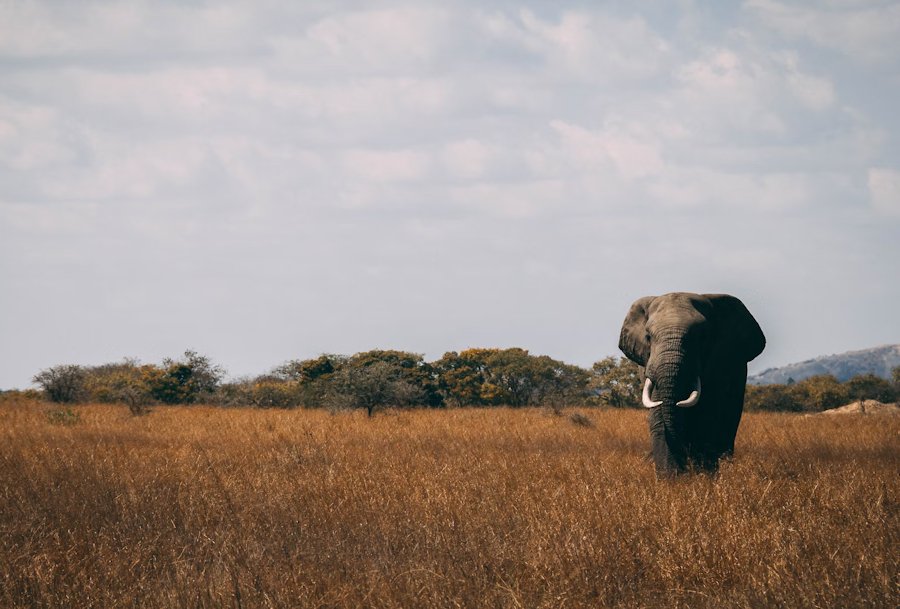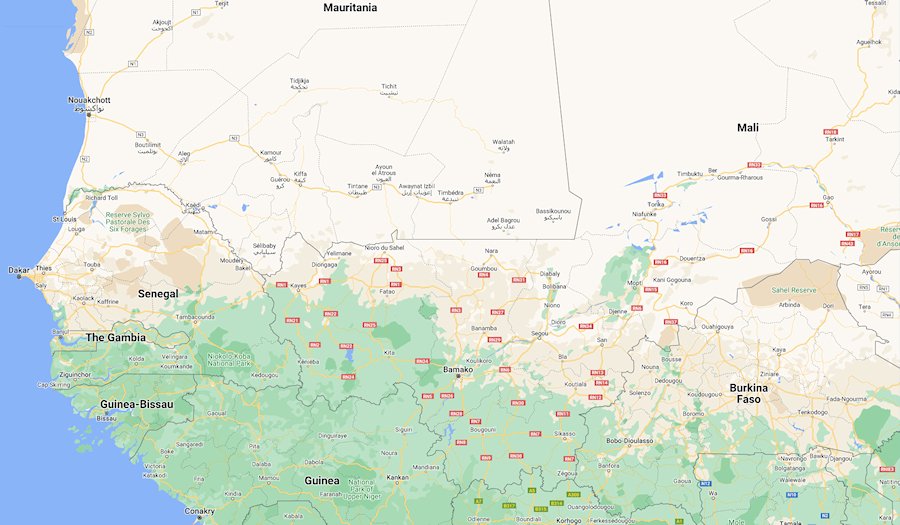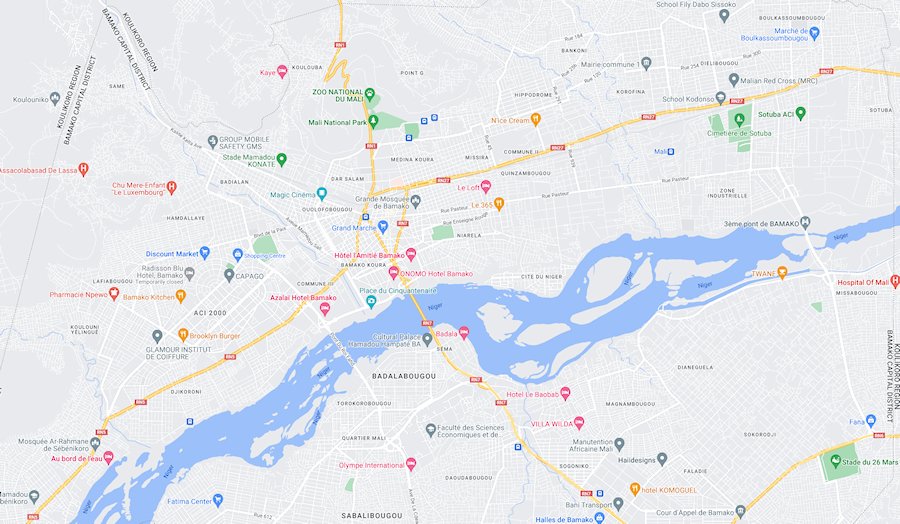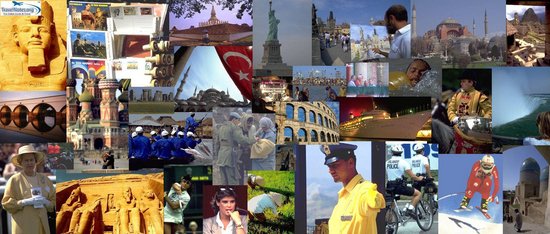Travel Notes: Africa - Mali Travel Notes.
Short URL: https://tnot.es/ML
Mali Travel and Tourism on Travel Notes
Mali Magic - Embrace the Soul-Stirring Beauty of West Africa
Discover the irresistible allure of Mali. Ancient traditions, breathtaking landscapes, and warm hospitality converge to create unforgettable travel experiences. Share on Facebook
About Mali
Mali used to be a popular destination, but tourism collapsed due to political unrest and security issues. Currently, most countries advise against travel to Mali.
Countries neighbouring Mali: Algeria, Niger, Burkina Faso, Côte d'Ivoire, Guinea, Senegal and Mauritania.
 Add a Business -
Add a Location -
Add a Lodging - Add Travel Content
- Add URL
- Travel Services.
Add a Business -
Add a Location -
Add a Lodging - Add Travel Content
- Add URL
- Travel Services.
Mapping Mali
Map of Mali
Mali shares borders with Algeria to the north, Niger to the east, Burkina Faso and Ivory Coast to the south, Guinea to the south-west, Senegal to the west, and Mauritania to the north-west.
Its capital is Bamako.
Mali Overview
Mali, officially known as the Republic of Mali, is a landlocked country located in West Africa.
The Republic of Mali, a former French colony, is the eighth largest country in Africa.
Culture and Religion
Mali has a rich cultural heritage with a blend of traditional African and Islamic influences.
Traditional music, dance, and art are an integral part of Malian culture.
The country is known for its musical traditions, particularly the globally acclaimed music genres of Mali such as griot, blues, and desert rock.
Islam is the predominant religion in Mali, with the majority of the population being Muslims.
However, there are also significant Christian and indigenous religious communities.
Demographics
Mali has a diverse population composed of different ethnic groups.
The largest ethnic group is the Bambara, followed by the Fula, Soninke, Tuareg, and others.
The country has a population of approximately 20 million people.
The official language of Mali is French, which is inherited from the colonial period. However, Bambara is widely spoken as a lingua franca throughout the country.
There are also several regional languages spoken by different ethnic groups.
Economy
Mali's economy is predominantly agrarian, with agriculture accounting for a significant portion of the country's GDP.
The main crops grown include cotton, millet, sorghum, rice, and corn.
Livestock farming is also an important economic activity.
Mali has rich mineral resources, including gold, which is one of the country's major exports.
Other natural resources include salt, uranium, limestone, and bauxite.
However, despite its resource wealth, Mali faces challenges in developing and diversifying its economy.
Geography and Environment
Mali is mostly flat, with the Niger River flowing through the southern part of the country.
The landscape is characterised by vast savannas, desert regions, and the Sahel, which is a transitional zone between the Sahara Desert in the north and the more fertile regions in the south.
The climate varies from arid in the north to semi-arid and tropical in the south.
History
Mali has a rich history that dates back to ancient times.
The area has been inhabited for thousands of years, and it was once part of the Ghana Empire, followed by the Mali Empire; which reached its height of power and prosperity under the legendary ruler Mansa Musa, in the 14th century.
The Mali Empire was known for its wealth, trade routes, and Islamic scholarship.
Over the centuries, Mali went through various political changes and experienced colonisation by the French in the late 19th century.
It gained independence from France on 22nd September, 1960, and established itself as the Republic of Mali.
Malian Challenges and Conflict
Mali has faced numerous challenges in recent years, including political instability, armed conflict, and terrorism.
In 2012, an insurgency began in the northern part of the country, led by various armed groups, including Tuareg separatists and Islamist militants.
This conflict, along with the spillover effects of the Libyan civil war, resulted in a complex security situation.
Efforts have been made by the Malian government and international partners to restore peace and stability, including the deployment of United Nations peacekeeping forces.
However, the situation remains fragile, and the country continues to face security and humanitarian challenges.
Despite the challenges, Mali has a resilient population and a rich cultural heritage that contribute to its identity as a vibrant nation.
French Sudan
Modern Mali was made part of the French colony of Haut-Senegal-Niger in 1904, and in 1920 it became the French Sudan.
On January 17, 1959, the French Sudan joined with Senegal to form the Federation of Mali; which proclaimed its independence on June 20, 1960.
The federation broke up in August. Senegal became a separate state, and the former French Sudan kept the name of Mali.
Early Times in Western Sudan
In earlier times, Mali was the centre of the great empires of the western Sudan: Ghana, Mali, and Songhai.
Djenne, Timbuktu, and Gao, were the focus of trade, religious learning, and culture.
The empire of Mali reached its peak in the early 14th century under Mansa Musa.
The Songhai Empire of Gao, took over, with kings Sunni Ali and Askia Muhammad coming to the throne.
The great Songhai Empire was in turn crushed by a Moroccan invasion in 1591.
The People of Mali
The Dogon tribe, part of the large Mandingo population in Mali, build their unique villages in cliffs and hilly areas.
Nomadic Tuaregs and other Berbers roam the Sahel and parts of the Sahara. Some of the armed Tuaregs have been known to rob or kidnap travellers in the north of Mali.
The official language of Mali is French, but the majority of the population speak Bambara or other African languages.
Islam is the main religion of Malians, although some people still follow traditional beliefs.
Visiting Mali
Located in West Africa, Mali is a beautiful country known for its rich cultural heritage, diverse landscapes, and historical sites.
It is important to note that before travelling to Mali, it's crucial to check the latest travel advisories, ensure your safety, and make necessary preparations for your trip.
Mali Highlights
For those lucky enough to visit Mali, these are some of the country's highlights.
Bamako
As the capital and largest city of Mali, Bamako is a vibrant and bustling metropolis.
Explore the National Museum of Mali to learn about the country's history and culture, visit the bustling markets like the Grand Marché for traditional crafts and textiles, or take a stroll along the Niger River.
Djenné
Known for its stunning mud-brick architecture, Djenné is a UNESCO World Heritage site.
The highlight of the town is the Great Mosque of Djenné; the largest mud-brick structure in the world.
Don't miss the opportunity to witness the traditional Monday market, where locals gather to sell various goods.
Dogon Country
The Dogon people are an ethnic group in Mali known for their unique culture and cliffside villages.
Trekking through the Dogon Country allows you to experience their ancient traditions, visit traditional villages, and witness breathtaking views of the Bandiagara Escarpment.
Mopti
Located at the confluence of the Niger and Bani rivers, Mopti is often referred to as the 'Venice of Mali'.
Explore the lively fishing port, take a boat ride along the rivers, and visit the old town known as Komoguel; where you can find traditional mud-brick architecture.
Sikasso
Situated in southern Mali, Sikasso is a region known for its fertile lands and agricultural activities.
It offers beautiful landscapes, including hills, waterfalls, and natural reserves.
Explore the lively markets, visit the Koutiala Cultural Centre, and enjoy the scenic beauty of the region.
Timbuktu
Located in the Sahara Desert, Timbuktu is a legendary city and UNESCO World Heritage site.
It was once an important centre of Islamic learning and trade.
Explore the ancient mosques, browse through the collections of ancient manuscripts, and soak in the mystical atmosphere of this historic city.
Getting Around Mali
Mali by Road
About ten per cent of Mali's 18,000 km of roads are paved.
Mali by Rail
A railway links Koulikoro, Bamako, and Kayes with Dakar, in Senegal.
Mali by Boat
The River Niger, cutting an arc through the southern part of Mali, is a valuable communication route; connecting the mysterious outpost of Timbuktu with Bamako.
Most of the River Niger, in Mali, is navigable by small steamboats from July to January. During the rainy season it is also possible to travel down the Senegal River from Kayes to Saint-Louis, on the Atlantic Ocean.
Mali by Air
Airlines and Airports:
International airports serve Bamako and Mopti. Air Mali is the state airline.
Bamako
Map of Bamako
Although little more than a village when it was occupied by French troops, in 1883, Bamako was an important centre of Muslim scholarship in the Mali Empire.
It became the capital of the colony of French Sudan in 1908 and continued as the national capital of Mali in 1960.
Today it is the focus of Malian music, and some excellent bands are staged at the Bamako Station Buffet.
Where to Stay in Bamako
Grand Hotel Bamako
Grand Hotel Bamako: Quartier du Fleuve, Bamako, Mali.
Experience the warmth and hospitality of West Africa, without foregoing the services and creature comforts you expect of top-notch hotels, at this landmark four-star property; located in the historic heart of Bamako.
Guests at the Grand Hotel Bamako liked the clean rooms, excellent service and great location.
Timbuktu
Tuareg Nomads founded Timbuktu as a seasonal camp on the southern edge of the Sahara around the year 1100.
Timbuktu became an important end station of trans-Saharan caravans and a distribution point for trade along the upper Niger when it was part of the Mali Empire, and a renowned centre of Islamic study in the Songhai Empire.
The city declined in importance after the Moroccans attacked, in 1591, and commerce was diverted to other cities.
Timbuktu is still best reached by boat or camel; making getting there something of an adventure in itself.
Mali Tours
Malian guides usually speak English, French and a variety of local languages.
Mali tour offers include sailing on the Niger River; camel caravans into the Sahara; hiking the Bandiagara escarpment; Timbuktu, Dogon country, Djenne and Mopti.
Mali Maps and Travel Guides
Mali Travel Guides - Mali Maps.
Weather in Africa:
Local weather forecasts for destinations around Africa.
|
|
More From Travel Notes
Travel Notes Online Guide to Travel
Africa - Asia - Caribbean - Europe - Middle East - North America - Oceania - South America.
The Travel Notes Online Guide to Travel helps visitors plan their trip with country and city travel guides, local tourist information, reviewed web sites, and inspiring travel content.
Travel and Tourism Guides on Travel Notes
 If you find Travel Notes useful, please take a moment to
like us on Facebook and share with your friends on social media.
If you find Travel Notes useful, please take a moment to
like us on Facebook and share with your friends on social media.
Share on Facebook
Travel Resources
.
Travel & Tourism With Industry Professionals.















